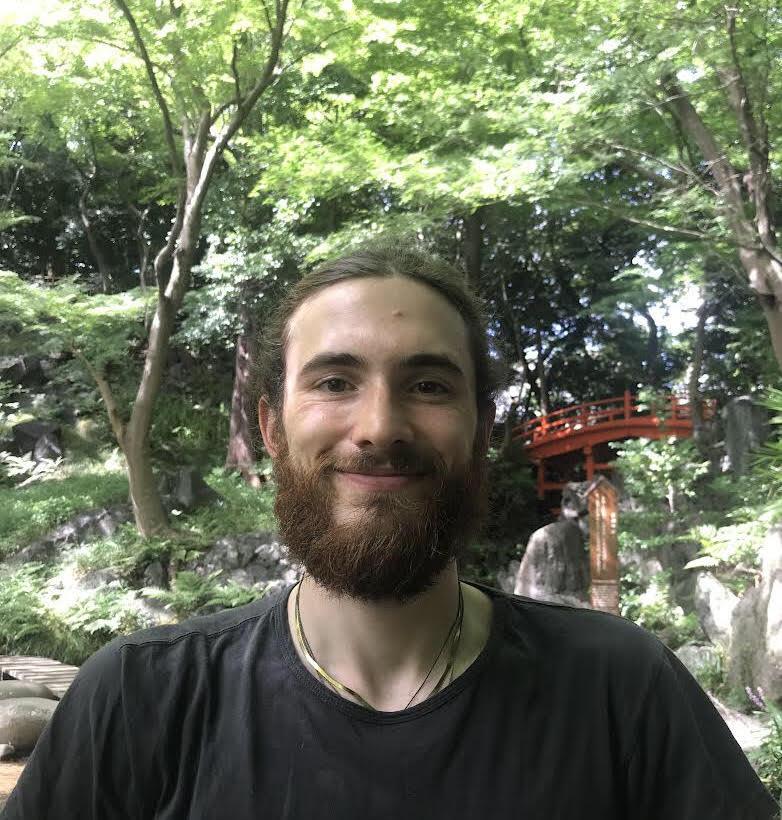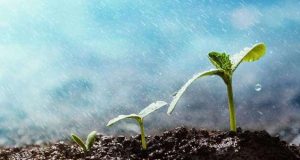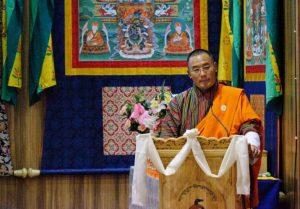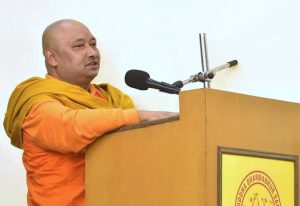Over the previous three parts of this series, we have traced the developmental arc of Vienna Svabhava’s journey from a tear-gassed Malaysian tunnel, through enlightenment engineering, and deep into the nexus of Silicon Valley techno-economic innovation.
Scattered yet intriguing, what remains to be fully illustrated in this headlong adventure are Vienna’s determined efforts at integration which, like any authentic path, tell the story of her pioneering work as an unfolding process more than any concretized outcome.

Reboot the Earth
In late August 2019, Greta Thunberg, then 16 years old, docked at the port of New York to participate in that year’s UN Climate Action Summit after a much-publicized trans-Atlantic voyage from Europe. Welcomed by hundreds of other youth climate activists connected to the #FridaysforFutures movement, Thunberg’s determination to courageously represent the frustration and discontentment of her generation sent disruptive waves through many layers of global discourse surrounding the burgeoning ecological crisis.
The effectiveness of Thunberg’s message—that the voices of youth must not only be respected but actively integrated into multigenerational climate and environmental policy—played a significant role in the Zero Degree Collaboratory’s pivot toward supporting high-school aged students as frontline advocates for a more sustainable future.
Shortly after Greta’s docking in New York, Vienna arrived to participate in the Climate Week NYC with the intention of passing on a message to the plucky Swedish influencer from Zero Degree co-founder Syed Shariq about the importance of developing an alternative cooling economy.

While in New York, Vienna saw a poster advertising a UN-sponsored hackathon titled “Reboot the Earth,” organized as a platform for technology developers to speed run innovative solutions to the flurry of issues spawning from unchecked environmental degradation.
Selecting the “Sports and Climate” challenge, Vienna quickly gathered four friends into a team, who were accepted to participate in the weekend-long hackathon, together with various groups from local high schools and universities.
Signs of life
Despite having only 48 hours to complete a working prototype, Vienna’s team won the hackathon with their development of a new wilderness sport designed to gamify the activity of geo-location, utilizing a mobile-based augmented reality platform. Titled “Signs of Life: The New Augmented Reality Sport Where Climate is the Winner,”1 the project was inspired by Vienna’s experience working with the indigenous people of Borneo, who have increasingly struggled with mass deforestation due to illegal land-grabbing.

Without determined coordinates marking the boundaries of ancestral lands, opportunistic developers have wantonly sold thousands of hectares of dense jungle to logging companies without fear of judicial repercussions. Proving ancestral claim to a given territory in court is challenging, requiring labor intensive orienteering through rainforests with GPS data tracking to find and document signs of life, such as old homes and burial sites.
To complicate matters, many indigenous youth have left their remote villages for the cities, leaving their elders—the ones capable of transmitting valuable oral traditions of place and power—without willing future stewards of lands that are already being clearcut.
The “Signs of Life” solution created a platform where a new breed of “climate athletes” could combine fitness, creativity, and technological savvy to gather critical data in the wild that would help turn court cases in favor of indigenous landholders. Using a mobile phone to navigate and map data points in augmented reality, urban enthusiasts could train in necessary way-finding skills before embarking on “quests” in the Borneo rainforest, seeking to validate the instructions given by indigenous elders or “quest masters.”

Combining “climate purpose” with physical challenge and adventure was a hit. After being selected as winners, the UN secretary general personally congratulated the Signs of Life team and pledged to further incubate the project for eventual launch and implementation.
Sadly, these promises proved to be empty. Instead of channeling funds into supporting Signs of Life or the other projects that won previous UN Climate Hackathons, additional money was used to organize more hackathons in different parts of the world. With minimal followup after the event, Vienna recognized that the hackathon’s corporate sponsors were far more interested in the publicity associated with kickstarting good ideas rather than making them happen.
Disillusioned by the UN’s seeming indifference to genuinely nurturing youth driven innovation, Vienna relocated to the Monastic Academy in Vermont, where she could recalibrate her efforts together with a community of fellow Dharma practitioners.
Algorithmic dana
Having connected with many student climate activists in New York, Vienna learned that a significant number intended to either take time away from their studies or drop out entirely to focus on full-time advocacy work. In need of accommodation and other necessities, Vienna and a small team at the Monastic Academy began developing “Project Bowl,” a simple matching algorithm intended to connect young activists with local patrons willing to support their choice of lifestyle.

Inspired by alms given in the temple gift economy (Skt., Pali: dana), wherein lay practitioners offer daily food and other material goods to monastics carrying alms bowls, Project Bowl sought an extension of this non-monetary communal support into the domain of climate activism.
While meeting an individual’s basic needs is important, Vienna’s team soon realized that their solution lacked a tangible way of gauging the positive or negative externalities associated with any given climate action. Sinking into this second-noble-truth-realm of causes and conditions, it became clear that without a means of tracking these externalities many climate activists may be unconsciously perpetuating the systems which they were trying to transform.
In fact, it was awareness of these personal externalities and the desire to bring more attention to this domain of individual responsibility that prompted Greta Thunberg to sail to New York instead of choosing to fly.
Understanding the cooling economy
As identified by Syed Shariq and others at the Zero Degree Collaboratory, the relationship between the time, temperature, and capital for any given activity indicates how heating or cooling that activity is to the system as a whole.

For example, in a traditional Malaysian village, if one family wished to move their home and belongings to another location, the entire community would gather and literally pick up the family house to walk it to the new plot. In the same or lesser amount of time that it would have taken a private moving company to pack everything up and move box by box, communal bonds were strengthened, fewer resources were used, and no money exchanged hands. Reinforcing the solidarity of the group, this coming together around an important transition event demonstrates an indigenous sensibility that we have all but lost to modern outsourced convenience.

While this example may seem a far cry from the realities of intensely urbanized life, the principles remain the same. To what degree are the resources you need to facilitate your activities reliant on the unnecessary expenditure of energy? Are there ways in which you could support your friends so that they too can reduce the impact of their activities? Could you carpool to the grocery store and go shopping together? These are examples of cooling actions that we all can consider to not only limit energy use but connect more deeply with each other.
On a more fundamental level, in order to successfully coordinate such activity, we must cultivate a high degree of trust. Developing this trust is both an internal and interpersonal practice of reciprocal exchange that strengthens our sense of belonging, care and interconnectivity. In this way, taking cooling economic actions cools our minds thereby creating a positive feedback loop in the direction of total coolness, or what Dharma practitioners call nirvana.
Prototyping Dharmic finance
Drawing on her experience with the Zero Degree Project, Vienna wanted to find a way of integrating the interdependent metrics of time, temperature, and capital into a functional sense-making tool for the climate conscious to better understand the impacts of their behavior.
Furthermore, to realize the goal of a global cooling economy, one in which economic activity and wealth creation do not further contribute to rising temperature, the presence of a positive incentive structure capable of rewarding “cooling” actions also seemed necessary.
Blending these two core needs, Vienna’s team evolved Project Bowl into Project Kelvin, described as an alternative financial system in alignment with the first Buddhist precept “to refrain from taking life.”
This experimental economic sandbox was designed to track the complex system impact of any logged activity on a public ledger, using both integrated assessment tools and subjective polling from others using the platform. The Project Kelvin team outlined their techno-Dharmic goal as such: “just like Google’s Pagerank algorithm caused people to optimize their content for search engines (SEO), we’re working to create new algorithms that cause people to optimize their actions for Wisdom (WEO).”

Participating in Project Kelvin meant that residents at the Monastic Academy would track individual activities and voluntarily report their data as transactions to the collective ledger. After posting their activity, users would be able to vote on if they felt a given transaction had a positive or negative impact. Transactions could also be objectively analyzed using built in tools such as carbon impact, allowing for an integration of quantitative and qualitative value judgements.
What kept the whole system flowing was a unique token issued as a reward to users who demonstrated positive impact activities. Gaining a token was akin to gaining trust from the other users and, as such, Project Kelvin’s currency was designed to promote a sense of togetherness and mutual support.

As the project became a part of life at the Monastic Academy, a variety of deeper experiments into intentionality were conducted to better understand how subjective values play a role in decision-making. If, for instance, one purchased a cross-continental flight to attend a dear friend’s wedding or visit a meditation teacher, was there a way of quantifying the positive subjective externalities of such a trip in comparison to the quantifiable carbon impact and money spent?
Embracing this new tool and the insights into interbeing that it presents started a Dharmic ripple at the Monastic Academy that has continued to today. Indeed, Project Kelvin’s capacity to render a vast chain of interconnections legible in both economic, social, and spiritual terms is a remarkable achievement of Dharmic finance that deserves more attention.

How to practice Buddhist economics
If Vienna’s work has at times sounded too abstract or conceptual to squarely land in relatable experience, kindly humor one final thought experiment in Buddhist economics.
Imagine preparing yourself for a short meditation practice in your own home. Arrange the space, light a stick of incense, and assume your preferred posture. As awareness of the breath slowly takes center stage and the flurry of thoughts begins to recede, consider what causes and conditions have furnished the space in which you practice.
Someone, perhaps yourself or another, built this structure with funds likely borrowed from a bank or similar lending institution. A mortgage or monthly rent is being levied against your occupation of this space and nearly every other building in both the neighborhood and nation. As such, a financial instrument is at play in your experience, flowing through it in quantifiable terms with every passing minute and every breath.
This fact connects you to an entire global web of financialized assets so complex and entangled that the possibility of true independence is a mere fantasy. We not only are each other’s environment, but we back each other’s environments through layers of financial instruments so vast and subtle that—in the absence of economic collapse—we are often completely oblivious.
Breathing with this weird world of value, we recognize our position as both particle and wave, at once capable of making “cooling” decisions that soften individual impact while consciously disengaging from deeper currents of capital without care.
Cooling our minds in such a way, opportunities begin to arise for the cooling of capital, i.e. aligning one’s consumption of resources and creation of wealth with less resource intensive means. For instance, the idea to convert a small balcony space into tomato patch or move into cooperative housing may arise and with tools such a Project Kelvin. The positive intentionality of such actions can be assessed, rewarded, and encouraged by other economically-engaged practitioners.

Concluding Thoughts
Novel sense-making mechanisms such as Project Kelvin indicate a new dawn in Buddhist economics, one in which the enormous potential of technology is harnessed by Dharmic awareness to rewire our understanding and engagement with the financial substrate of reality. As the cumulative fruit of more than a decade of exploration, synthesis, and experimentation, Vienna’s efforts to bridge Eastern perspectives with Western innovation has opened Dharma doors to programmers, scholars, and tech bros alike. With inexhaustible enthusiasm and commitment to the integration of Right Technology for the benefit of all beings, it is Digital Bodhisattva’s such as Vienna who initiate the shifts we all can nurture in service to each other and our biosphere.
1 “Signs of Life” – The New Augmented Reality Sport Where Climate is the Winner (United Nations)
See more
ViennaO (Linktree)
Zero Degree Collaboratory
Digital Bodhisattva (Facebook)
Digital Bodhisattva (Clubhouse)
Digital Bodhisattva Initiative (Linktree)
International Network of Engaged Buddhists (INEB)
INEB (Twitter)
Related features from BDG
Vienna in the Silicon Pure Land, Part 1: Feeling into the Dharma of Emerging Technology
Vienna in the Silicon Pure Land, Part 2: Navigating the Wild Wired West
Vienna in the Silicon Pure Land, Part 3: Reimagining Buddhist Economics
Related videos from BDG
BDG Special Issue
Digital Dharma – Buddhism in a Changing World












